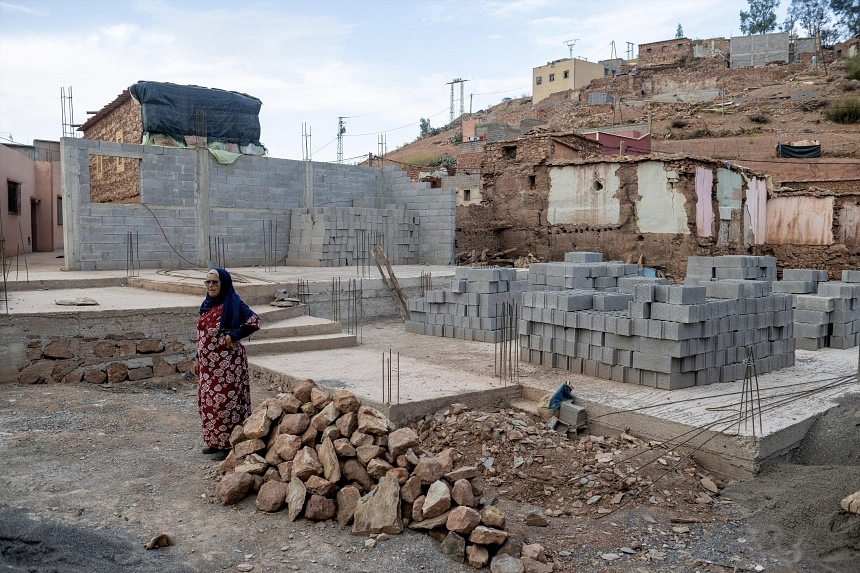
One year after a powerful earthquake struck Morocco, the mountain communities most affected by the quake are still working to rebuild.
Here in Amizmiz, one of the larger towns in the hard-hit Al Haouz region, most of the buildings remain as damaged as they were in the aftermath of the earthquake.
The 6.8 magnitude quake, the biggest to hit the North African country in 120 years, struck on September 8, 2023 and killed nearly 3,000 people.
Many buildings in villages and towns around Morocco’s High Atlas mountains, like in Amizmiz, were reduced to rubble.
Although much of the damage remains, there are glimmers of hope.
Some homes have been rebuilt and others are under construction, with new foundations being dug and bricks being laid.
However, the process of restoring normal life has been slow to begin.
In the year since the earthquake shook the town, its residents have had to navigate a multi-step bureaucracy to secure the needed funds to rebuild their homes.
After authorities assessed the damage, households were provided 8,000 to 16,000 euro sums ($8,900 – $17,800) to rebuild their homes, offered in instalments. Some also received cash support for immediate needs.
Abderrahim Alachoun, a plumber in Amizmiz, is in the process of rebuilding his home.
“I got the first and second installments of support, which is $4,000, to rebuild. We are now waiting for the third installment to complete the construction work. We feel that things are going well despite the delay in these procedures,” he says.
In another mountain village called Imi N’Tala, the damage was much worse. This village was almost completely destroyed by the earthquake, which led the authorities to decide not to rebuild the houses there due to the risk of falling rocks from the mountain.
Some mobile homes made of tin in another nearby location were offered as a temporary solution to the residents who lost their homes, but many of them reject this solution and insist on staying on their land in makeshift tents, considering the land part of their identity.
“The residents want to stay in this place, they all want to stay here because they have agricultural land there where they grow vegetables and it is their source of livelihood. If they go somewhere else and abandon this place, they will not be able to live there,” explains Mohammed Soumer, a Imi N’Tala resident whose home was destroyed.
Tinmel was another hard-hit village.
It’s famous for the historic Tinmel Mosque – a mosque that was under renovation and almost complete before the earthquake struck and destroyed a large part of it.
Now, a year after the earthquake, the restoration process has begun again. Work is underway to rebuild the mosque with the aim of preserving this historical site that is part of the cultural and religious heritage of the region.
Near the mosque, some residents are rebuilding their homes, but this time they have chosen to use modern construction techniques instead of the traditional methods that were used in the past.
“We are working on rebuilding the house well and strongly and we are trying to use strong building materials. I have not yet obtained the building permit, but I have obtained the support. I received $250 per month,” says Tinmel resident Mohammed Ait Saleh.
For residents, the focus is on making their homes durable to protect them from possible earthquakes in the future.
“We are not afraid now because we are rebuilding the house well. We are using good and strong building materials. I used iron supports of 12-centimetre thickness and strong foundations here. I got the building permit and everything is fine,” explains local resident Redouane Ait Saleh.
According to the Moroccan government, nearly 1,000 families have been able to complete the reconstruction or repair of their homes, 55,142 reconstruction permits have been issued, and 2,500 dirhams have been disbursed as monthly support for 63,862 families.
Those who have not yet received support have been forced to seek alternative sources of funds to rebuild or stay in temporary housing, waiting for the completion of the necessary procedures to begin reconstruction work.
It seems for many residents of these areas, the road to normality is still long.
“In the future if the people return to this village and if they repair their homes and rebuild the other homes then we can feel hopeful,” notes Lehcen Moujjane, a tailor in Amizmiz.
Though earthquakes are rare in North Africa, last year’s earthquake was one of the strongest ever recorded in the region.
It originally displaced some 500,000 people, and damaged or destroyed nearly 60,000 homes.





